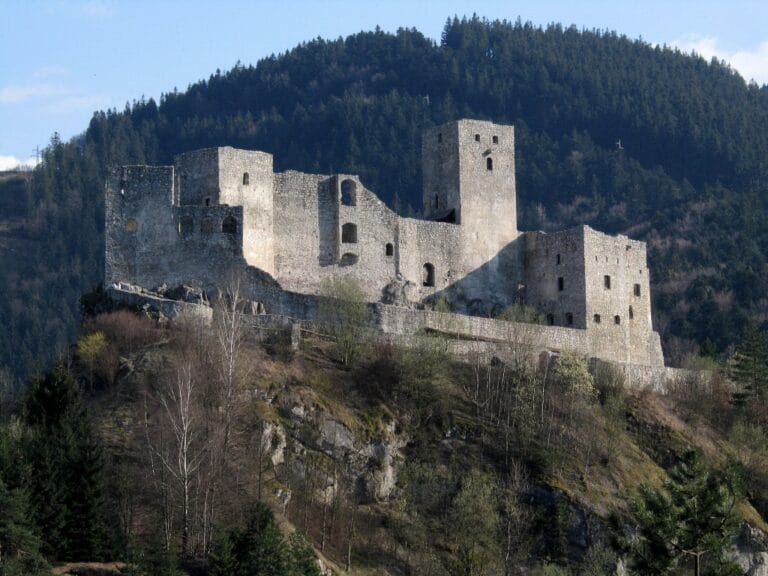Liptov Castle: A Historic Medieval Fortress in Slovakia
Visitor Information
Google Rating: 4.7
Popularity: Low
Google Maps: View on Google Maps
Country: Slovakia
Civilization: Medieval European
Remains: Military
History
Liptov Castle stands near the village of Liptovská Sielnica in present-day Slovakia. The site was originally fortified by communities during the Iron Age, with an earlier hillfort established here around the 1st century BCE. The medieval castle itself was constructed in the mid-13th century by direction of King Béla IV of Hungary, following the devastating Mongol invasion of 1241–1242.
The first written record of the castle appears in a 1262 letter from King Béla IV, indicating its importance as a defensive stronghold. Positioned on a hill overseeing the western Liptov Basin and the Sesterská Valley, the castle protected a key trade route leading northwest to Orava and onward to Poland. In the late 13th and early 14th centuries, Liptov Castle came under the control of notable figures such as the powerful noble Matthew Csák and the župan (county leader) Donč, who ruled from 1313 until 1337. By 1340, the castle had become the administrative center of the Liptov župa, serving as the seat for regional governance.
Originally, the castle’s domain covered the entire Liptov territory, reaching beyond the Choč Mountains to include villages like Malatiná. However, as new castles were built nearby—namely Likava and Liptovský Hrádok—the boundaries of Liptov Castle’s holdings gradually shrank. The 13th and 14th centuries were marked by frequent destruction and rebuilding of the fortress. Between 1431 and 1434, Hussite forces occupied the castle during their regional campaigns.
In 1447, the castle was destroyed because it had become a refuge for robber knights. Seven years later, the noble Pongrác took possession and undertook repairs to the residential quarters, also adding a more modern curtain wall (a defensive outer wall). Starting in 1459, Piotr Komorowski, a Polish magnate supporting the Jagiellonian family’s claim to the Hungarian throne, held control. After an unsuccessful attempt by young Casimir Jagiellon to assert power in 1471, King Matthias Corvinus compelled Komorowski to surrender Liptov Castle. In 1474, Matthias ordered the complete demolition of the fortress to prevent its future use.
Following this destruction, the castle was largely left in ruin. Over time, it became known by various names, including Pustý hrad (meaning “Deserted Castle”), Starý hrad (“Old Castle”), and the Hungarian Óvar (“Old Castle”). Its remote location contributed to its decline in prominence and near-forgetting until archaeological efforts began in the late 20th century. Excavations that started in 1976 under Dr. Václav Hamuliak shed new light on the castle’s development and helped preserve its remains.
Remains
Liptov Castle was built atop Sestrč Hill, nearly 1,000 meters above sea level, making it the highest castle site in Slovakia and among the highest in Central Europe. The hill features steep rock faces on two sides and sharp slopes on the other two, creating a natural defense that shaped the castle’s layout.
The earliest phase of the castle included a residential tower, a small enclosed courtyard with defensive walls, two gates, and a single water cistern to serve inhabitants. Archaeological work has uncovered foundations of these structures along with two water cisterns, suggesting an advanced system for collecting and storing water on the hilltop. The 15th-century modifications added an extended curtain wall, known locally as a parkán, enhancing the castle’s protective perimeter.
Excavations have also revealed remains of the residential palace and several towers. Of particular interest is the discovery of a smithy beneath the western defensive wall, which yielded numerous projectiles such as arrowheads or stones used during sieges, alongside blacksmithing tools and materials. This indicates that the castle was prepared for prolonged military engagements and housed active metalworking operations.
The site’s long history includes prehistoric occupation before the medieval fortress. Evidence of a Hallstatt culture settlement was found, including a semicircular earthwork enclosing a fortified area from the early Iron Age. Nearby, a small cave known to have been inhabited since the Eneolithic period underlines the hill’s significance across millennia.
Today, only fragments of the castle’s walls remain visible above ground, mostly concealed under grassy overhangs and soil. These remnants preserve valuable information about the site’s architectural evolution and its role through centuries of Central European history.







